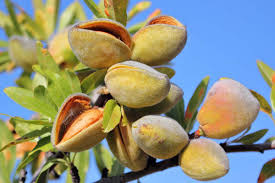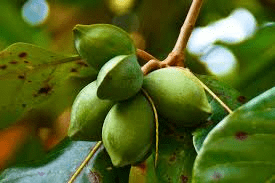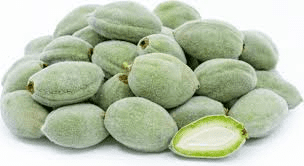The almond fruit, botanically known as the drupe, is the fruit of the almond tree (Prunus dulcis). It is a small, oval-shaped fruit with a hard outer hull, or shell, that encases the almond seed inside.
The almond fruit starts as a small, green, fuzzy drupe that grows on the almond tree. As the fruit matures, the outer hull gradually dries and hardens, eventually splitting open to reveal the almond seed inside. The almond seed, or kernel, is the edible part of the fruit that is prized for its rich flavor and nutritional benefits.
While the almond fruit itself is not typically consumed, the almond kernel inside is widely used in culinary applications and food products. Almond kernels can be eaten raw or roasted as a snack, added to cereals, granolas, or trail mixes, or used as an ingredient in cooking and baking. They are also ground into almond flour, which is used as a gluten-free alternative to traditional wheat flour in baking recipes.
In addition to their culinary uses, almond kernels are highly nutritious and packed with essential nutrients. They are an excellent source of healthy fats, protein, fiber, vitamins, and minerals, including vitamin E, magnesium, and calcium. Regular consumption of almond kernels as part of a balanced diet may offer numerous health benefits, including improved heart health, better blood sugar control, and enhanced weight management.
Overall, while the almond fruit itself is not typically consumed, the almond kernel inside is a versatile and nutritious ingredient that is prized for its delicious taste and numerous health benefits.
The Economic Importance and Uses of Almond Fruit

1. Nut Production: The primary economic importance of almond fruit lies in its nut production. Almonds are cultivated for their edible seeds, known as almond kernels, which are a valuable agricultural commodity consumed worldwide.
2. Culinary Use: Almond fruit is widely used in culinary applications, both in its fresh and processed forms. Fresh almonds can be eaten as a nutritious snack, while processed almonds are used in baking, confectionery, and cooking.
3. Export Trade: Almond fruit is a significant commodity in international trade. Major almond-producing regions, such as California in the United States and Spain, export almonds to global markets, contributing to economic growth and trade relationships.
4. Nutritional Value: Almond fruit is valued for its nutritional content, being rich in protein, healthy fats, fiber, vitamins, and minerals. Its nutritional profile makes it a popular choice for health-conscious consumers and those with dietary preferences.
5. Snack Industry: Almond fruit plays a crucial role in the snack industry. Almonds are consumed as a convenient and healthy snack, available in various forms such as whole almonds, roasted almonds, flavored almonds, and almond mixes.
6. Ingredient in Recipes: Almond fruit is used as an ingredient in various recipes and dishes. Almond kernels are incorporated into desserts, salads, entrees, and baked goods, adding flavor, texture, and nutrition to culinary creations.
7. Almond Milk Production: Almond fruit is processed to produce almond milk, a dairy-free alternative to cow’s milk. Almond milk is consumed by individuals with lactose intolerance or those following a vegan diet, contributing to the plant-based milk market.
8. Almond Butter Production: Almond fruit is used to produce almond butter, a creamy spread made from ground almonds. Almond butter is a nutritious alternative to peanut butter and is used in sandwiches, smoothies, and recipes.
9. Almond Oil Extraction: Almond fruit is processed to extract almond oil, a versatile oil used in cooking, skincare, haircare, and aromatherapy. Almond oil is valued for its moisturizing and nourishing properties in cosmetic and culinary applications.
10. Pharmaceutical Use: Almond fruit extracts are utilized in the pharmaceutical industry for their potential health benefits. Almond extracts may be incorporated into supplements, medicines, and cosmetic formulations for their antioxidant and anti-inflammatory properties.
11. Almond Flour Production: Almond fruit is ground into almond flour, a gluten-free flour alternative used in baking recipes for cakes, cookies, pancakes, and bread. Almond flour is suitable for gluten-sensitive individuals and adds a nutty flavor to baked goods.
12. Almond Paste Production: Almond fruit is processed into almond paste, a sweet and sticky mixture used in pastry fillings, marzipan, and confectionery products. Almond paste adds flavor and texture to desserts and baked goods.
13. Almond Extract Production: Almond fruit is soaked in alcohol to produce almond extract, a concentrated flavoring used in baking, confectionery, and culinary applications. Almond extract enhances the almond flavor in recipes.
14. Almond Snack Production: Almond fruit is processed into various almond snacks, including roasted almonds, flavored almonds, almond clusters, and coated almonds. These snacks are enjoyed as convenient, nutritious options for on-the-go snacking, contributing to the diverse range of snack products available in the market.
15. Almond Confectionery: Almond fruit is a key ingredient in confectionery products such as chocolate-covered almonds, almond nougat, and almond brittle. These confections combine the sweet taste of chocolate or caramel with the crunchiness of almonds, appealing to consumers with a sweet tooth.
16. Almond Desserts: Almond fruit is featured in a variety of desserts, including almond cakes, almond cookies, almond tarts, and almond puddings. These desserts showcase the rich flavor and texture of almonds, delighting dessert lovers around the world.
17. Almond Yogurt and Ice Cream: Almond fruit is used to produce dairy-free yogurt and ice cream alternatives made from almond milk. These products cater to consumers seeking plant-based options and those with dairy allergies or lactose intolerance.
Read Also: The Curry Leaves: Economic Importance, Uses, and By-Products
The Products and By-products That Can Be Derived From Almond Fruit

1. Almond Kernel: The almond kernel is the edible seed found inside the almond fruit. It is harvested, processed, and used in various culinary and industrial applications, including snacking, baking, cooking, and oil extraction.
2. Almond Hulls: Almond hulls are the outer shell or husk that surrounds the almond kernel within the fruit. They are a by-product of almond processing and can be used as animal feed, biomass fuel, or agricultural mulch.
3. Almond Shell: The almond shell is the hard, woody covering that encases the almond kernel and hull. It can be utilized as biomass fuel, soil amendment, animal bedding, or filler material in various industrial processes.
4. Almond Oil: Almond oil is extracted from almond kernels and is used in cooking, skincare, haircare, and aromatherapy. It is prized for its moisturizing, nourishing, and aromatic properties in cosmetic and culinary applications.
5. Almond Flour: Almond flour is made from finely ground almond kernels and is used as a gluten-free flour alternative in baking recipes. It adds a nutty flavor and moist texture to baked goods such as cakes, cookies, and muffins.
6. Almond Milk: Almond milk is produced by blending soaked almond kernels with water and straining the mixture to remove solids. It is a dairy-free milk alternative consumed by individuals with lactose intolerance or vegan dietary preferences.
7. Almond Butter: Almond butter is made from ground almond kernels and is used as a spread or ingredient in sandwiches, smoothies, and recipes. It is a nutritious source of protein, healthy fats, and vitamins.
8. Almond Extract: Almond extract is made by soaking almond kernels in alcohol to extract their flavor compounds. It is used as a concentrated flavoring agent in baking, confectionery, and culinary applications.
9. Almond Meal: Almond meal is coarsely ground almond kernels with a texture similar to breadcrumbs. It is used as a gluten-free alternative in baking, breading, and as a crunchy topping for dishes.
10. Almond Paste: Almond paste is made from ground almond kernels mixed with sugar or syrup to form a sweet and sticky mixture. It is used in pastry fillings, marzipan, and confectionery products for its rich almond flavor.
Read Also: How to Store Lettuce
Frequently Asked Questions (FAQ’s) About Almond Fruit

1. What is almond fruit?
Almond fruit is the fruit of the almond tree (Prunus dulcis), which contains a hard shell enclosing the edible almond kernel. It is harvested for its seeds, which are consumed as nuts and processed into various products.
2. Is almond fruit the same as almonds?
Yes, almond fruit refers to the whole fruit of the almond tree, including the hull, shell, and kernel. Almonds are the edible seeds found within the almond fruit, which are commonly consumed as nuts.
3. How are almonds harvested?
Almonds are harvested by shaking the almond tree branches or using mechanical tree shakers to dislodge the nuts from the tree. Once harvested, the almonds are collected from the ground and processed to remove the hull and shell, revealing the edible kernel.
4. What are the nutritional benefits of almond fruit?
Almond fruit is rich in protein, healthy fats, fiber, vitamins (such as vitamin E), and minerals (such as magnesium and calcium). It is a nutrient-dense food that promotes heart health, weight management, and overall well-being.
5. Can almond fruit be eaten raw?
Almond fruit itself is not typically eaten raw due to its tough and fibrous hull. However, the almond kernel found within the fruit is edible and can be consumed raw or roasted as a nutritious snack.
6. How are almonds processed?
After harvesting, almonds undergo processing to remove the hull and shell, revealing the edible kernel. The almonds are then sorted, graded, and packaged for sale as whole nuts or further processed into almond products such as almond milk, almond butter, and almond flour.
7. Are almond products suitable for people with nut allergies?
Almonds are considered tree nuts, and individuals with nut allergies should avoid consuming almond products to prevent allergic reactions. It’s essential to read food labels carefully and be aware of cross-contamination risks in food products.
8. Are there different varieties of almonds?
Yes, there are various almond varieties cultivated for commercial production, each with its unique flavor, size, and characteristics. Some popular almond varieties include Nonpareil, Carmel, Mission, and Butte.
9. Can almond fruit be grown at home?
Almond trees can be grown at home in regions with a suitable climate, such as Mediterranean climates with mild winters and hot, dry summers. However, almond trees require specific growing conditions and may not thrive in all environments.
10. What is the shelf life of almond products?
The shelf life of almond products varies depending on the type of product and how it is stored. Whole almonds stored in a cool, dry place can last for several months to a year, while processed almond products such as almond milk or almond butter may have shorter shelf lives and require refrigeration after opening.
Read Also: How to Choose the Right Trash Service for Your Needs

